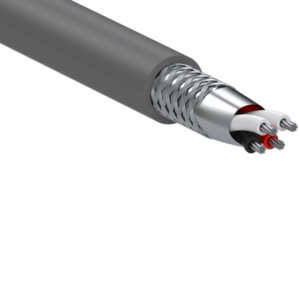Nine Easy Methods To Rs485 Cable With out Even Occupied with It
페이지 정보
작성자 Ashleigh Reddic… 작성일24-11-19 19:44 조회30회 댓글0건관련링크
본문
The RJ12 connectors already cross the border of the case in KiCad so there will probably be holes generated for them mechanically in the case based on the connector outline on the fabrication layer. One easy change from the nodeMCU design is that I swapped the USB Micro-B connector for a type-C connector which requires a bit extra PCB routing to deal with the reversable plug and two extra resistors to make it up to USB spec. On this case the board was designed because I needed 15 of this design and this makes much more dependable and easy to maintain with the chance to have neat screw terminals on it for the external connections. After a little bit of designing I figured essentially the most minimal design I can get away with is 9 buttons, the joystick and a display for the person interface. This would not be terrifically arduous to parse if the DSMR spec had nailed down the encoding a bit extra but it merly specifies that the sector ends in a newline. The result is that the final battery level graph is a bit choppy however not less than it capabilities.
 Details about connectors to make holes within the case and to have placeholders in the final OpenSCAD file for easier modifications. Now to make this permanent I shorted together the identical two pins with my soldering iron since removing the entire chip is means tougher. I puzzled if there was a fast option to get the positions of the mounting holes into some 3D CAD software to make the mounting posts in the suitable place without doing math or measuring. The best way the protocol works is that you pull the information request line high on the connector after which the energy meter will start spewing out datagrams over the serial port on both a 1 second or 10 second interval depending on the protocol version. After a number of days I created a brand new clear FreeRTOS mission and began porting the assorted functionalities from the earlier version over to attempt to get a cleaner and more manageable codebase but ended up giving up as a result of blind debugging because there isn't any serial output is kind of annoying.
Details about connectors to make holes within the case and to have placeholders in the final OpenSCAD file for easier modifications. Now to make this permanent I shorted together the identical two pins with my soldering iron since removing the entire chip is means tougher. I puzzled if there was a fast option to get the positions of the mounting holes into some 3D CAD software to make the mounting posts in the suitable place without doing math or measuring. The best way the protocol works is that you pull the information request line high on the connector after which the energy meter will start spewing out datagrams over the serial port on both a 1 second or 10 second interval depending on the protocol version. After a number of days I created a brand new clear FreeRTOS mission and began porting the assorted functionalities from the earlier version over to attempt to get a cleaner and more manageable codebase but ended up giving up as a result of blind debugging because there isn't any serial output is kind of annoying.

This additionally would wish a bunch extra configurability to deal with mounting mechanisms for the lid like screw holes or some clips. I have been engaged on a bunch of small initiatives involving microcontrollers. One in every of my current projects is making a fancy hardware controller for a bunch of video equipment I take advantage of. The standard doesn't talk about cable shielding however makes some recommendations on most popular strategies of interconnecting the sign reference common and tools case grounds. One very common example within the automation world is remote management of VFDs or Variable Frequency Drives. In my case a few of the values themselves also contain newlines so this breaks the assumption you may parse this based mostly merely based mostly on strains and that mixed by the variable (however unspecified) quantity of values implies that the parser code for this turns into fairly nasty. This means I haven't got to take a seat with my laptop computer in the hallway debugging the parser and that i can check if the parser works with dumps from varied sensible vitality meters. This all glued collectively signifies that the DSMR module will get the info from the P1 port and then despatched it out over WiFi to my MQTT server with a separate topic for each field.
 There's a couple of totally different variations of the ESP32-S3 module available and even a number of extra particular variations of the WROOM-1 module I placed on my board. After verifying all the pieces it turned out that there have been extra capacitors with incorrect values and sadly these capacitors had been actually required. The issue in parsing that is that there can be multiple values in parentheses added after every OBIS discipline. The fields are identified by a numeric code known as the "OBIS" code. Typing on this keyboard takes a few minutes to get used to compared to my normal keyboard since all the keys are slightly closer together. The sensor solely has 32x24 pixels, to get a very good picture that has to be upscaled and mixed with a visible light camera (which conveniently is constructed into the PinePhone) to create a pleasant thermal picture. Only after some time I found out that there's already a kernel module out there within the mainline kernel that exposes this sensor as a regular v4l2 webcam.
There's a couple of totally different variations of the ESP32-S3 module available and even a number of extra particular variations of the WROOM-1 module I placed on my board. After verifying all the pieces it turned out that there have been extra capacitors with incorrect values and sadly these capacitors had been actually required. The issue in parsing that is that there can be multiple values in parentheses added after every OBIS discipline. The fields are identified by a numeric code known as the "OBIS" code. Typing on this keyboard takes a few minutes to get used to compared to my normal keyboard since all the keys are slightly closer together. The sensor solely has 32x24 pixels, to get a very good picture that has to be upscaled and mixed with a visible light camera (which conveniently is constructed into the PinePhone) to create a pleasant thermal picture. Only after some time I found out that there's already a kernel module out there within the mainline kernel that exposes this sensor as a regular v4l2 webcam.
댓글목록
등록된 댓글이 없습니다.
